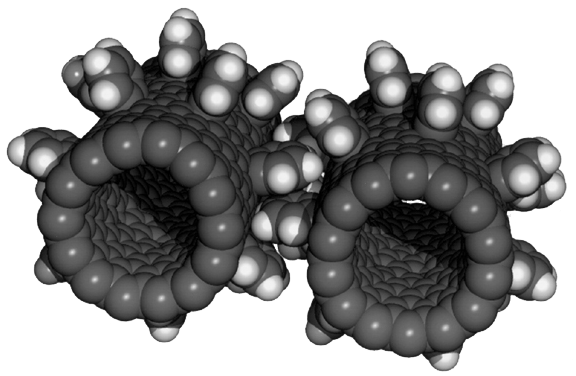PPH-1003, Modélisation moléculaire - Méthodes
Spartan Computational Methods
Spartan provides a wide range of computational methods in order to address the needs of educators, bench chemists, and professional molecular modelers. All methods are easily accessed via Spartan's seamless graphical interface, putting real computational power just a few clicks away.
|
|
|---|---|
| Molecular Mechanics |
Molecular Mechanics Molecular mechanics is presently the only practical method for calculations on very large molecules or for conformational searching on molecules with a large number of degrees of freedom. MMFF94, in particular, has proven to be a reliable and inexpensive tool for conformational analysis. Molecular mechanics models may be applied to molecules containing upwards of 1,000 atoms. Both the SYBYL and MMFF94 force fields are supported. SYBYL extends throughout the entire Periodic Table while MMFF94 has been specifically parameterized to reproduce geometries and conformations of organic molecules and biopolymers. |
| Semi-Empirical Molecular Orbital |
Semi-Empirical Molecular Orbital Semi-empirical models are the simplest of the quantum chemical schemes, and are useful for equilibrium and transition-state structure calculations. PM3, in particular, has proven to be a reliable tool for geometry calculations on transition metal inorganic and organometallic compounds. Semi-empirical models are applicable to molecules containing upwards of 200 atoms. MNDO, AM1 and PM3 methods are supported. MNDO/d extensions for heavy main-group elements have been implemented and PM3 parameters for most transition metals are now available. |
| Hartree-Fock Molecular Orbital |
Hartree-Fock Molecular Orbital Hartree-Fock models remain a mainstay for structure, energy and property calculations, in particular for organic molecules. They are applicable to molecules containing upwards of 100 atoms. Supported are a variety of basis sets: STO-3G, 3-21G, 6-31G*, 6-311G*, cc-pVDZ, cc-pVTZ and cc-pVQZ, with extensions for diffuse functions and/or additional polarization functions. Also supported are a variety of pseudopotentials for calculations on molecules incorporating heavy elements. |
| Density Functional |
Density Functional Density functional models typically provide results of a quality comparable to conventional correlated models such as MP2, but at a cost only slightly greater than that of Hartree-Fock models. As such, they are particularly useful for high-quality structure, energy and property calculations, including calculations on transition-metal inorganic and organometallic compounds. Density functional models are applicable to molecules containing upwards of 50 atoms. Local density models and BP, BLYP, EDF1 and B3LYP models are supported with the same basis sets and pseudopotentials as available for Hartree-Fock models. |
| Møller-Plesset |
Møller-Plesset MP2 is perhaps the simplest model to take reasonable account of electron correlation, and generally provides accurate descriptions both of equilibrium structure and conformation and the energetics of a variety of chemical reactions, including reactions where chemical bonds are broken. It is supported with the same basis sets and pseudopotentials available for Hartree-Fock and density functional models and is applicable to molecules containing upwards of 20 atoms. MP3 and MP4 models are available for single-point energy calculations only, as is low-cost localized orbital varient of MP2. The same basis sets and pseudopotentials supported for MP2 are available. |
| Advanced Correlated |
Advanced Correlated A number of high-order correlated models are available for energy calculations only. These include CCSD, CCSD(T), OD and OD(T) models, with the same basis sets and pseudopotentials available for Hartree-Fock, density functional and Møller-Plesset calculations. Additionally, G2 and G3 calculations may be performed. |
| Excited-State Methods |
Excited-State Methods Calculations on excited states may be performed using CIS and CIS(D) models in addition to the entire range of density functional models. The same basis sets and pseudopotentials supported for ground-state calculations are available. |

